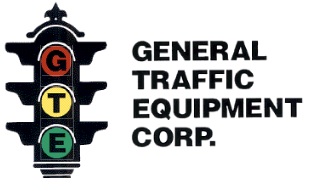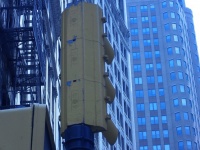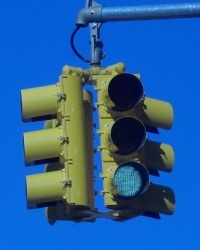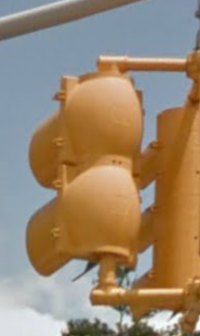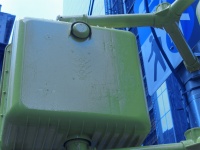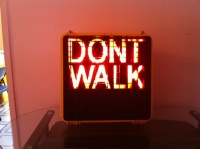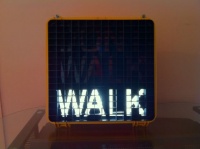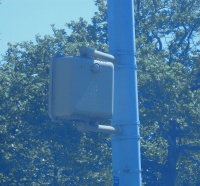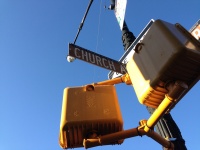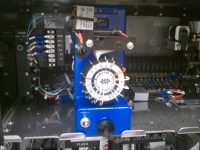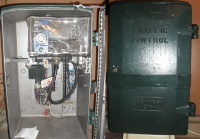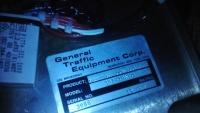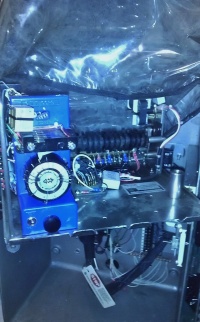Difference between revisions of "General Traffic Equipment"
| (69 intermediate revisions by 3 users not shown) | |||
| Line 2: | Line 2: | ||
==Background== | ==Background== | ||
| − | General Traffic Equipment (also commonly known as G.T.E.) is an American, family-owned signal equipment company that was established in 1978. Since then, the company has provided its own line of signals, equipment, and signal controllers to various states in the country. The company's president is Raymond G. Staffon. Originally, General Traffic Equipment's headquarters was based in Yonkers, New York; however, | + | General Traffic Equipment (also commonly known as G.T.E.) is an American, family-owned signal equipment company that was established in 1978. Since then, the company has provided its own line of signals, equipment, and signal controllers to various states in the country. The company's president is Raymond G. Staffon. Originally, General Traffic Equipment's headquarters was based in Yonkers, New York; however, in the 2000s, the company relocated to the city of Newburgh in New York, in which is the current location. All products of the company are manufactured on premises and sent to its customers. One of the company's largest customers to date is the city of New York. |
[[File:G.t.e.jpg|right|]] | [[File:G.t.e.jpg|right|]] | ||
| + | ==Vehicular Signals== | ||
| − | + | Along the lines of vehicular signals, General Traffic Equipment has several models to choose from. Both aluminum and polycarbonate, not to mention, in regards to size, 8 and 12 inch. Most of what has been manufactured could be viewed in service throughout the city of New York today, and many of these heads have been in service as far back as the late 1990s. These are typically 8" vehicular signals, and two variations of this size are known to exist on the streets. The first version is an aluminum housing that is practically identical to that of the model TE-19408 housing from [[Marbelite]], which was manufactured from the mid 1960s until the late 1970s. Incandescent signal indications were originally in use, and then L.E.D. signal indications appeared in later years. As of present day, General Traffic Equipment no longer manufactures this 8" model.[[File:SDC14151.JPG|200px|thumb|left|The back of an 8" first generation aluminum vehicular signal housing from G.T.E. From lower Manhattan in New York City. Picture taken by Steven Gembara.]] | |
| − | |||
| − | [[File: | + | In the late 2000s, the second kind of 8" head was introduced by the company, and its housing is also aluminum. Furthermore, the housing resembles that of an 8" Eagle Mark IV housing, in which the back appears round. General Traffic Equipment does not offer incandescent signal indications for this version, and tunnel visors are typically used for the head, though cutaway and fully circular visors are considered as options as well. This traffic signal has spread throughout various locations in New York City within the past four years or so. Aside from aluminum, a polycarbonate version exists as well. One difference to point out is that, between both kinds, the polycarbonate version uses two latches for each door, while the aluminum version uses only one for each door. [[File:Untitled 1.jpg|200px|thumb|right|An example of a cluster of 8" 2nd generation aluminum vehicular signals from G.T.E. At the corner of Luten Av. and Eyelandt St. Staten Island in New York City. Picture taken by Steven Gembara.]] |
| − | |||
| − | In continuation of several vehicular signal models offered by General Traffic Equipment, 12" heads are produced as well. A version made of aluminum and polycarbonate exist, and each kind is common to see in some states, like New Jersey and New York, for example. The back of | + | In continuation of several vehicular signal models offered by General Traffic Equipment, 12" heads are produced as well. A version made of aluminum and polycarbonate exist, and each kind is common to see in some states, like New Jersey and New York, for example. The back of the housing is round in appearance, and it appears similar to that of a 12" Eagle/Siemens vehicular signal. The difference can be seen [http://highwaydivides.com/wiki/index.php?title=File:Gtesiemenscomparisonpyth.jpg here]. |
[[File:12 inch GTE.png|200px|thumb|left|Two-section 12" traffic signal from G.T.E. From Staten Island in New York City. Courtesy of Google Map.]] | [[File:12 inch GTE.png|200px|thumb|left|Two-section 12" traffic signal from G.T.E. From Staten Island in New York City. Courtesy of Google Map.]] | ||
| + | |||
To meet various municipalities' needs, General Traffic Equipment offers several different colors for its vehicular signals aside from the rather ordinary factory yellow, such as dark olive green, black, and gray. The company could also take special requests. | To meet various municipalities' needs, General Traffic Equipment offers several different colors for its vehicular signals aside from the rather ordinary factory yellow, such as dark olive green, black, and gray. The company could also take special requests. | ||
| + | ==Pedestrian Signals== | ||
| + | General Traffic Equipment's first line of pedestrian signals appeared sometime in the 1990s. At the time, the first model was the P-6. Made from polycarbonate, this model was composed of a 16" housing, which encased a reflector assembly for illumination and a two-piece polycarbonate lens (available as "DONT WALK" and "WALK" and the hand and man). The door contained a louver, which protected the two-piece lens behind it from mainly vandalism. This piece was fire retardant and had a box-grid design. In regards to the housing itself, the model P-6 had a rather unique characteristic, in which a small ventilation hole was located on the top portion of the back of the housing. Its purpose was simply to remove unwanted heat created by the illumination of the light bulbs inside, and a cap covered the ventilation hole which prevented debris and insects from entering the inside of the housing. | ||
| − | |||
| − | General Traffic Equipment's | + | Because of General Traffic Equipment's significant involvement with the city of New York, the model P-6 pedestrian signal spread rapidly throughout New York City from the 1990s until the early 2000s. During this time period, D.O.T. of New York City typically installed it at a newly constructed signalized intersection, while it sometimes replaced an older pedestrian signal. Other times, it was part of an upgrade at an existing signalized intersection. In addition to the usage in the city of New York, the P-6 was also in use elsewhere in New York state. |
| − | |||
| + | [[File:SDC14162.JPG|200px|thumb|right|A close-up of the back of a G.T.E. P-6 16" polycarbonate housing. Notice the use of the ventilation hole and cap. From lower Manhattan in New York City. Picture taken by Steven Gembara.]] | ||
| − | [[File: | + | [[File:GTE001.jpg|200px|thumb|left|The front view of a model P-6. Illuminated as "DONT WALK." From user "mcorivervsaf."]] |
| − | [[File: | + | [[File:Untitled.jpg|200px|thumb|left|Same view of the model P-6. Illuminated as "WALK." From user "mcorivervsaf."]] |
[[File:G.T.E. P-6 housing.jpg|200px|thumb|right|A view of the side and back of a model P-6. From Staten Island in New York City. Bay Street. Picture taken by Steven Gembara]] | [[File:G.T.E. P-6 housing.jpg|200px|thumb|right|A view of the side and back of a model P-6. From Staten Island in New York City. Bay Street. Picture taken by Steven Gembara]] | ||
| − | The model P-6 was compatible with L.E.D. inserts, and this was ideal for the time period | + | The model P-6 was compatible with L.E.D. inserts, and this was ideal for the time period when alterations of pedestrian signals took place in New York City from 2000 to 2005 or so. The conversion from "DONT WALK" and "WALK" to the hand and man was possible, and General Traffic Equipment once offered solely pedestrian signal housings for the installations, which led to General Traffic Equipment's discontinuation of the option for the signal to use incandescent illumination sometime in the mid 2000s. The company would also eventually discontinue production of the P-6 and introduce the second version of the model shortly afterward. |
| + | |||
| + | |||
| + | The second generation P-6 is practically identical to the first generation as far as design is concerned, but one difference to mention is that the second version has a modified ventilation hole on the back of the housing, and a large cap is not in use, since a smaller one is present. Because incandescent signal indications are outdated, General Traffic Equipment does not offer the option to have the second generation P-6 available as either an incandescent "DONT WALK" and "WALK" or hand and man; however, a box-grid louver is optional. | ||
| + | |||
| + | |||
| + | [[File:IMG 3949.jpg|200px|thumb|right|A pair of G.T.E. 2nd generation P-6 pedestrian signals in use. From Brooklyn, New York.]] | ||
| + | |||
| + | General Traffic Equipment also manufactures the model P-7 pedestrian signal, in which the housing is made from aluminum. The entire design is similar to that of a 16" McCain and I.C.C. pedestrian signal, and it solely uses a L.E.D. hand and man insert. The company offers a louver and visor for the front of the housing. It is not in use in New York City; however, one could assume it is in use elsewhere. | ||
| + | |||
| + | |||
| + | Like its line of vehicular signal models, the company also offers several different colors to municipalities to choose from. The selection is the same, and, in addition to this, special requests could be taken into consideration. | ||
| + | |||
| + | ==Signal Controllers== | ||
| + | |||
| + | Since 1984, General Traffic Equipment has been manufacturing and distributing its own line of electro-mechanical signal controllers. They were in use in several states in the country such as Louisiana and New York, and some remain in useful service today, such as in the city of New York. Because electro-mechanical signal controllers are outdated in today's world of traffic control, General Traffic Equipment manufactures them only upon special request. As of present day, General Traffic Equipmet is believed to be the only signal equipment company in America that still manufactures electro-mechanical signal controllers. | ||
| + | |||
| + | |||
| + | There are a handful of electro-mechanical signal controller models that were and are manufactured by the company. These signal controllers show similarities to some signal controllers from the M-30 series of the company Marbelite. Aside from the actual equipment, some of the cabinets themselves also share similarities to what was produced by Marbelite, both small and large. Because of the similarities amongst both kinds of electro-mechanical signal controllers, some parts of the actual signal controllers are interchangeable, so it could be observed in some signal controller cabinets that parts from each company are in use. | ||
| + | |||
| + | [[File:Img 20120725 164820.jpg|200px|thumb|left|Up-close view of an electro-mechanical signal controller from G.T.E. From the headquarters of N.Y.C.D.O.T.]] | ||
| + | |||
| + | |||
| + | General Traffic Equipment offers options for its electro-mechanical signal controllers, such as 1 to 3 dial timers on a signal controller tray, amount of signal circuits depending on the complexity of a signalized intersection, flasher type, and so on and so forth. A majority of those manufactured are pre-timed, so each one follows one time plan according to the configuration of the dial timer itself; however, these could be semi-actuated as well. | ||
| + | |||
| + | [[File:2124348228 f3611c9293 o.jpg|200px|thumb|right|The interior of a large G.T.E. B-3 type cabinet. The signal controller model is that of a special model that was designed for the city of New York in order to meet N.Y.C.D.O.T. specifications. An advantage of the large cabinet is that it provides ample space for the equipment in use inside, not to mention other related equipment (if necessary). Picture taken by user Mack Male of Flickr.]] | ||
| + | |||
| + | |||
| + | While these signal controllers were in use at various locations in the country, they are well known in the city of New York. It is believed that electro-mechanical signal controllers from General Traffic Equipment first appeared on the streets in the 1990s and spread throughout the boroughs in later years. At the time, such a signal controller was typically installed at a newly constructed signalized intersection, since N.Y.C.D.O.T. continued to use electro-mechanical signal controllers until the early 2000s. Other times, one replaced an older signal controller. The signal controller cabinets were painted dark green and frequently used heavy duty lock rings, which generally prevented vandalism. Most of the signal controllers controlled ordinary two-phase signalized intersections, while others controlled fairly more complex signalized intersections in New York City. Though a large percentage of such signal controllers are no longer in use today, some still remain in useful service in various locations. | ||
| + | |||
| + | |||
| + | Since some municipalities apparently continue to use electro-mechanical signal controllers, General Traffic Equipment has its own inventory of used electro-mechanical signal controller parts, like cams and dial timers. Aside from its own parts, the company possesses spare parts from several signal equipment companies that once manufactured electro-mechanical signal controllers, such as General Electric, Marbelite, Eagle, and Econolite. | ||
| + | |||
| + | |||
| + | Aside from electro-mechanical signal controllers, General Traffic Equipment recently entered the world of computerized signal controllers, and one is being designed. It is unclear when this signal controller will first enter the market. | ||
| + | |||
| + | [[File:NYC GTE 301 19NYC.jpg|200px|thumb|left|Two pictures of a G.T.E. electro-mechanical signal controller which was designed for usage in the city of New York. Model 301 19NYC. Notice the use of the heavy duty lock ring on the outside of the cabinet. From the collection of Steven Gembara.]] | ||
| + | |||
| + | [[File:GTE NYC LABEL.jpg|200px|thumb|right|Close-up of a decal on the signal controller tray. From the collection of Steven Gembara.]] | ||
| + | |||
| + | [[File:GTE 301 19NYC TRAY.jpg|200px|thumb|left|A view of the typical G.T.E. signal controller which was commonly used at many signalized intersections throughout New York City. From the collection of Steven Gembara.]] | ||
| + | |||
| + | <br clear=all> | ||
| − | + | ==Restored Examples== | |
| + | <gallery> | ||
| + | File:Gte1stgenfrontpyth.jpg|1st Gen GTE front | ||
| + | File:Gte1stgeninsidepyth.jpg|1st Gen GTE inside | ||
| + | File:Gte1stgenlogopyth.jpg|GTE logo | ||
| + | File:Gte1stgenmarbpyth.jpg|[[Marbelite]]'s name still cast into the 1st gen doors. | ||
| + | </gallery> | ||
Latest revision as of 13:09, 21 June 2014
Contents
Background
General Traffic Equipment (also commonly known as G.T.E.) is an American, family-owned signal equipment company that was established in 1978. Since then, the company has provided its own line of signals, equipment, and signal controllers to various states in the country. The company's president is Raymond G. Staffon. Originally, General Traffic Equipment's headquarters was based in Yonkers, New York; however, in the 2000s, the company relocated to the city of Newburgh in New York, in which is the current location. All products of the company are manufactured on premises and sent to its customers. One of the company's largest customers to date is the city of New York.
Vehicular Signals
Along the lines of vehicular signals, General Traffic Equipment has several models to choose from. Both aluminum and polycarbonate, not to mention, in regards to size, 8 and 12 inch. Most of what has been manufactured could be viewed in service throughout the city of New York today, and many of these heads have been in service as far back as the late 1990s. These are typically 8" vehicular signals, and two variations of this size are known to exist on the streets. The first version is an aluminum housing that is practically identical to that of the model TE-19408 housing from Marbelite, which was manufactured from the mid 1960s until the late 1970s. Incandescent signal indications were originally in use, and then L.E.D. signal indications appeared in later years. As of present day, General Traffic Equipment no longer manufactures this 8" model.
In the late 2000s, the second kind of 8" head was introduced by the company, and its housing is also aluminum. Furthermore, the housing resembles that of an 8" Eagle Mark IV housing, in which the back appears round. General Traffic Equipment does not offer incandescent signal indications for this version, and tunnel visors are typically used for the head, though cutaway and fully circular visors are considered as options as well. This traffic signal has spread throughout various locations in New York City within the past four years or so. Aside from aluminum, a polycarbonate version exists as well. One difference to point out is that, between both kinds, the polycarbonate version uses two latches for each door, while the aluminum version uses only one for each door.
In continuation of several vehicular signal models offered by General Traffic Equipment, 12" heads are produced as well. A version made of aluminum and polycarbonate exist, and each kind is common to see in some states, like New Jersey and New York, for example. The back of the housing is round in appearance, and it appears similar to that of a 12" Eagle/Siemens vehicular signal. The difference can be seen here.
To meet various municipalities' needs, General Traffic Equipment offers several different colors for its vehicular signals aside from the rather ordinary factory yellow, such as dark olive green, black, and gray. The company could also take special requests.
Pedestrian Signals
General Traffic Equipment's first line of pedestrian signals appeared sometime in the 1990s. At the time, the first model was the P-6. Made from polycarbonate, this model was composed of a 16" housing, which encased a reflector assembly for illumination and a two-piece polycarbonate lens (available as "DONT WALK" and "WALK" and the hand and man). The door contained a louver, which protected the two-piece lens behind it from mainly vandalism. This piece was fire retardant and had a box-grid design. In regards to the housing itself, the model P-6 had a rather unique characteristic, in which a small ventilation hole was located on the top portion of the back of the housing. Its purpose was simply to remove unwanted heat created by the illumination of the light bulbs inside, and a cap covered the ventilation hole which prevented debris and insects from entering the inside of the housing.
Because of General Traffic Equipment's significant involvement with the city of New York, the model P-6 pedestrian signal spread rapidly throughout New York City from the 1990s until the early 2000s. During this time period, D.O.T. of New York City typically installed it at a newly constructed signalized intersection, while it sometimes replaced an older pedestrian signal. Other times, it was part of an upgrade at an existing signalized intersection. In addition to the usage in the city of New York, the P-6 was also in use elsewhere in New York state.
The model P-6 was compatible with L.E.D. inserts, and this was ideal for the time period when alterations of pedestrian signals took place in New York City from 2000 to 2005 or so. The conversion from "DONT WALK" and "WALK" to the hand and man was possible, and General Traffic Equipment once offered solely pedestrian signal housings for the installations, which led to General Traffic Equipment's discontinuation of the option for the signal to use incandescent illumination sometime in the mid 2000s. The company would also eventually discontinue production of the P-6 and introduce the second version of the model shortly afterward.
The second generation P-6 is practically identical to the first generation as far as design is concerned, but one difference to mention is that the second version has a modified ventilation hole on the back of the housing, and a large cap is not in use, since a smaller one is present. Because incandescent signal indications are outdated, General Traffic Equipment does not offer the option to have the second generation P-6 available as either an incandescent "DONT WALK" and "WALK" or hand and man; however, a box-grid louver is optional.
General Traffic Equipment also manufactures the model P-7 pedestrian signal, in which the housing is made from aluminum. The entire design is similar to that of a 16" McCain and I.C.C. pedestrian signal, and it solely uses a L.E.D. hand and man insert. The company offers a louver and visor for the front of the housing. It is not in use in New York City; however, one could assume it is in use elsewhere.
Like its line of vehicular signal models, the company also offers several different colors to municipalities to choose from. The selection is the same, and, in addition to this, special requests could be taken into consideration.
Signal Controllers
Since 1984, General Traffic Equipment has been manufacturing and distributing its own line of electro-mechanical signal controllers. They were in use in several states in the country such as Louisiana and New York, and some remain in useful service today, such as in the city of New York. Because electro-mechanical signal controllers are outdated in today's world of traffic control, General Traffic Equipment manufactures them only upon special request. As of present day, General Traffic Equipmet is believed to be the only signal equipment company in America that still manufactures electro-mechanical signal controllers.
There are a handful of electro-mechanical signal controller models that were and are manufactured by the company. These signal controllers show similarities to some signal controllers from the M-30 series of the company Marbelite. Aside from the actual equipment, some of the cabinets themselves also share similarities to what was produced by Marbelite, both small and large. Because of the similarities amongst both kinds of electro-mechanical signal controllers, some parts of the actual signal controllers are interchangeable, so it could be observed in some signal controller cabinets that parts from each company are in use.
General Traffic Equipment offers options for its electro-mechanical signal controllers, such as 1 to 3 dial timers on a signal controller tray, amount of signal circuits depending on the complexity of a signalized intersection, flasher type, and so on and so forth. A majority of those manufactured are pre-timed, so each one follows one time plan according to the configuration of the dial timer itself; however, these could be semi-actuated as well.

While these signal controllers were in use at various locations in the country, they are well known in the city of New York. It is believed that electro-mechanical signal controllers from General Traffic Equipment first appeared on the streets in the 1990s and spread throughout the boroughs in later years. At the time, such a signal controller was typically installed at a newly constructed signalized intersection, since N.Y.C.D.O.T. continued to use electro-mechanical signal controllers until the early 2000s. Other times, one replaced an older signal controller. The signal controller cabinets were painted dark green and frequently used heavy duty lock rings, which generally prevented vandalism. Most of the signal controllers controlled ordinary two-phase signalized intersections, while others controlled fairly more complex signalized intersections in New York City. Though a large percentage of such signal controllers are no longer in use today, some still remain in useful service in various locations.
Since some municipalities apparently continue to use electro-mechanical signal controllers, General Traffic Equipment has its own inventory of used electro-mechanical signal controller parts, like cams and dial timers. Aside from its own parts, the company possesses spare parts from several signal equipment companies that once manufactured electro-mechanical signal controllers, such as General Electric, Marbelite, Eagle, and Econolite.
Aside from electro-mechanical signal controllers, General Traffic Equipment recently entered the world of computerized signal controllers, and one is being designed. It is unclear when this signal controller will first enter the market.
Restored Examples
Marbelite's name still cast into the 1st gen doors.
